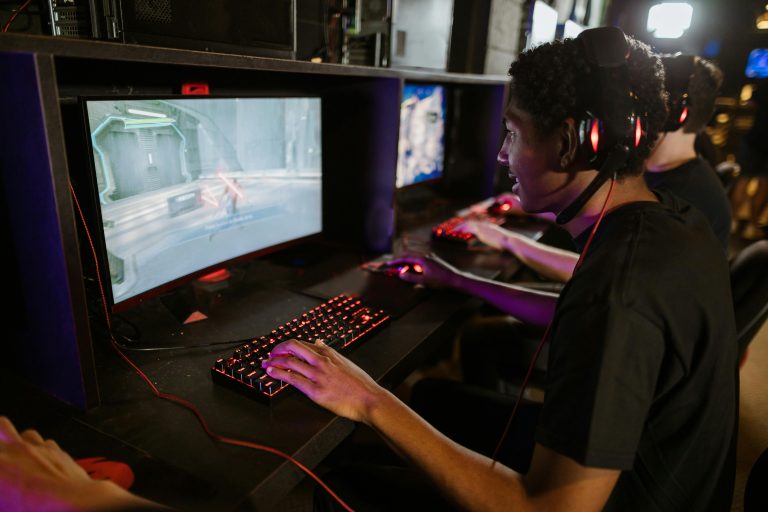
The whir of a server fan is the new sound of a paintbrush hitting canvas. The click-clack of a keyboard is the modern chisel striking marble. We are standing at the precipice of a new golden age for interactive entertainment, not because of a new console or a more powerful graphics card, but because of a fundamental shift in how games are created. Artificial intelligence, once a distant promise on the horizon, has now fully embedded itself into the very fabric of game development. In 2025, AI is no longer just a tool; it is a collaborative partner, an infinite idea generator, and the key to unlocking experiences of unprecedented scale, personalization, and dynamism. The entire pipeline, from the first spark of an idea to the final polish before release, is being reimagined and supercharged by machine learning, fundamentally revolutionizing what it means to be a game developer and, more importantly, what it means to be a player.
From Blank Canvas to Living World: AI-Powered Content Creation
The most visually stunning impact of AI in 2025 is in asset generation. The days of artists manually crafting every brick, leaf, and piece of armor are fading. Generative AI models, trained on vast datasets of artistic styles, can now produce high-fidelity, game-ready assets from simple text prompts or concept art.
A developer can describe a “weathered, moss-covered stone dungeon wall with iron sconces” and have a dozen variations in seconds. This doesn’t replace artists; it empowers them. Artists become art directors, curating and guiding the AI, focusing their precious time on unique, hero assets and establishing a cohesive visual direction while the AI handles the time-consuming work of populating the world. This extends to 3D model generation, texture creation, and even animation, where AI can generate fluid, realistic movements based on physics and biomechanics rather than countless hours of manual rigging and keyframing.
The End of Scripted NPCs: The Dawn of Dynamic Characters and Stories
For decades, non-player characters (NPCs) have been bound by rigid decision trees and pre-written dialogue. In 2025, advanced large language models (LLMs) and behavioral AI are shattering these chains. NPCs now possess simulated memories, personalities, and goals. They can engage players in unique, unscripted conversations that remember past interactions and influence the world state.
Imagine a shopkeeper who remembers if you were rude to them last week and now charges you double. Or a quest-giving character who can dynamically alter their request based on what’s happening in the game world at that very moment. This technology enables emergent storytelling, where narratives are not written by a single author but co-created by the player’s actions interacting with a world of intelligent agents. The quest log is no longer a static checklist but a living document of your unique impact on a responsive world.
Procedural Progression: Worlds That Build Themselves
Procedural generation is not new, but AI has evolved it from creating random landscapes to crafting meaningfully designed experiences. AI-powered procedural generation in 2025 is about intent and design. Game developers can set high-level parameters—”create a hostile swamp biome with a sunken temple at its center and winding paths that encourage vertical exploration”—and the AI will generate not just the geometry, but also place enemies, vegetation, lighting, and audio cues that align with that design goal.
This creates vast, unique worlds for players to explore while ensuring every area feels intentionally designed, not just randomly assembled. This is crucial for live-service games and open-world titles, providing a near-infinite stream of fresh, coherent content without requiring thousands of human hours to build each element by hand.
Hyper-Personalized Gameplay: The AI Game Master
Every player is different, but until now, games have largely offered one-size-fits-all experiences. AI is changing that by acting as a personal director or game master for each individual player. By analyzing player behavior in real-time—their playstyle, skill level, decisions, and even moments of frustration or boredom—the AI can dynamically adjust the game.
This could mean subtly tuning difficulty by spawning fewer enemies for a struggling player or creating more complex challenges for an expert. It could guide a player who seems lost by having an NPC offer a hint, or it could introduce a completely unexpected story event tailored to a player’s specific choices. This creates a deeply personal connection to the game, ensuring that the challenge is always engaging and the narrative feels uniquely yours. The game is no longer a static piece of software but an adaptive system that evolves with you.
Revolutionizing the Development Pipeline
Beyond the game itself, AI is streamlining the entire development process. Bug testing is accelerated by AI agents that can play the game millions of times, exploring every possible permutation to find crashes and exploits far faster than any human QA team. Code assistants suggest optimizations and help debug complex issues. Marketing teams use AI to analyze trends and predict audience reception. This massive increase in efficiency reduces development time and costs, allowing smaller studios to compete with AAA giants and enabling developers to focus their energy on creativity and innovation rather than repetitive tasks.
Conclusion
The integration of AI into game development is not about removing the human element; it’s about augmenting human creativity. It’s a paradigm shift from craftsmanship to curation, from scripting to simulating. The role of the game developer is evolving into that of a world-builder and systems architect, defining the rules and boundaries within which AI and players can co-create unforgettable experiences. In 2025, the future of play is more dynamic, more personal, and more immersive than ever before. We are moving beyond playing a game to stepping inside a living, breathing world that knows us and changes for us. The revolution is not coming; it is already here, and it is rewriting the rules of play, one algorithm at a time.






